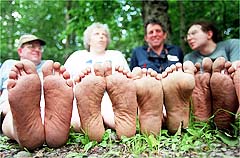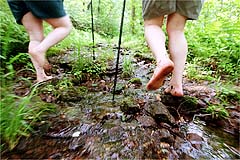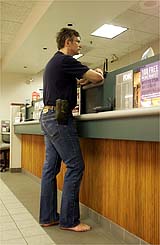July 12, 2000
The Barefoot Seek Wiggle Room
By PAM BELLUCK
|


Photographs by Will Waldron for The New York Times
|
Members of Barefoot Hikers relaxed on a recent trek on the Slide Mountain Trail in the Catskills. The group has 17 chapters; at least one member has hiked all 46 High Peaks of the Adirondacks.
|
OMBARD, Ill. -- "From the
ankles up," Gordon Hlavenka said,
"I'm a fairly normal person."
Sure, because from the ankles
up, Mr. Hlavenka is fully clothed.
But his feet -- sans shoes, sans
socks -- were on a kind of kamikaze mission in this well-heeled Chicago suburb recently, padding into
a bank, a market, McDonald's for
a cheeseburger and fries, and Wal-Mart, where an employee barked,
"Can't walk around here without
shoes -- that's against the law."
Shrugging off such shoeism, Mr.
Hlavenka politely replied that
barefooting is legal.
"I'll take a bullet for the cause,"
said Mr. Hlavenka, who runs an
electronics store, barefoot. "Usually I only have my shoes on about
an hour or two a week."
The barefoot cause is apparently
gaining ground. Hundreds of otherwise conventional people are baring their toes in unconventional
places, saying it is comfortable,
liberating, environmentally friendly, even spiritually enlivening.
Some like the adrenaline rush of
rebellion that spices their lives.
And they like feeling through their
feet: pebbly sidewalks, grainy dirt,
velvety moss, polished floors.
Many do it year-round.
|

Todd Buchanan for The New York Times
|
Gordon Hlavenka of the Dirty Sole Society, a group that shuns shoes, says, "From the ankles up, I'm a fairly normal person."
|
Elliott Adams, mayor of Sharon
Springs, N.Y., near Schenectady,
has gone barefoot in museums,
restaurants, at his logging company and walking to Village Hall.
"I
try to be shod when I'm being
mayor, try to remember to wear
shoes," said Mr. Adams, 53, who
owns size 12 wingtips. "But often I
just don't have them."
Marnen Laibow-Koser, 25, a violinist from Peekskill, N.Y., has
barefooted nonstop since May 5,
playing concerts in Manhattan in
tux and toes. Alicia Poe, 28, of
Queens, with her daughters, ages 2
and 3, barefoots everywhere from
Fifth Avenue to the Bronx Zoo.
And the Rev. David Vallelunga
of the United Methodist Church in
Saratoga Springs, N.Y., enjoys secular barefooting so much he performs services and weddings that
way -- "my exodus," he calls it.
"Bare feet is symbolic of innocence and simpler times," Mr. Vallelunga, 39, said. "The Greeks
fought barefoot. Everything
changed in the world when you
could step on the dead body of a foe
with impunity. We pay more for
sneakers in this country than people in some countries make in a
year. Plus, I feel very confined and
out of touch when I'm in shoes."
Then there is Robert Neinast of
Pickerington, Ohio, and his Gandhiesque standoff on a vacation to
Washington in the summer of 1999.
After barefooting to the Lincoln
and Jefferson Memorials ("the
marble steps are just so nice to
step on"), he was forced into flip-flops by guards at the Smithsonian
Institution. He wrote the museum
to complain, enclosing proof that
barefooting there is legal, received
a conciliatory letter, and revisited
with 10 barefoot compatriots.
"You need a thick skin, not just
on the soles of your feet," said Mr.
Neinast, 45, a software engineer at
Lucent Technologies, where, he
said, barefooting in the halls sent
him to "a psychological evaluation." He added, "Now I just do it
at my desk."
Mr. Neinast's civil rights victory
notwithstanding, barefooters are
not numerous enough for, say, a
Million Toes March (although that
is only 100,000 people). But the
Dirty Sole Society, dedicated to
"helping one another to get along
in a shod world," has attracted
more than 600 members since its
inception a few years ago. There is
Parents for Barefoot Children and
17 chapters of Barefoot Hikers,
whose practitioners include Mr.
Adams, whose toughened, calloused feet have hiked all 46 High
Peaks of the Adirondacks.
"It's one more sensory avenue,"
Mr. Adams said.
"You pick up a lot
of information through your feet.
Wearing shoes is a little like wearing mittens or a tie. If you don't
have to, why wear them?"
Many say the Internet emboldened them to shoe-tree their loafers. The www.barefooters.org Web
site debunks the widespread assumption that laws ban barefooters from driving or entering
most stores, restaurants and workplaces. (Businesses may set no-bare-feet policies.) While most podiatrists say shoes are essential
for protection and support, the
Web site quotes articles suggesting bare feet are less prone to
athlete's foot and hammer toes
and are healthy unconstricted.
As for stepping on filth or broken
glass, the site advises, "Watch
where you're going!" People constantly scrape their hands and "no
body thinks, 'This would not have
happened if I wore gloves,' " it
says. The site suggests retorts to
critics and lists barefoot-friendly
businesses, including a dentist and
a barefoot real estate broker in
California, and a beer-brewing
supply store in Georgia.
"It shows you that you're not
alone, you're not that peculiar,"
Mr. Neinast said.
"The Web site is an enabler,"
said Mr. Hlavenka, who keeps
backup size 11 1/2 EE sneakers in
his car. "It's like, 'Hello, my name
is Gordon and I hate to admit this
but I wore shoes yesterday.' "
Like many, Mr. Hlavenka, 42,
began tentatively, after sneakers
he bought three years ago made
his feet smell. He barefooted
around the block at night so neighbors would not see. He went to self-serve gas stations, eventually going inside for milk. Now he says he
primarily reserves his shoes for
church, and when his wife makes
him "chameleon" it. He even shovels snow barefoot.
Some barefooters push society's
envelope; others avoid confrontation, especially when shod friends
and family members are along.
Paul Lucas, founder of the Dirty
Sole Society, wears soleless sandals to restaurants. Jill Hamell of
Parsippany, N.J., who says barefooting eased painful foot problems, has tackled Penn Station and
Midtown Manhattan, but slipped
on sandals for Starbucks. (Tip:
Women carrying shoes get fewer
glares; people assume they are
resting sore feet.)
Mr. Vallelunga wears shoes on
hospital visits and at funerals.
Mike Berrow, a Web designer,
meets vendors and prospective
employees barefoot but wears
shoes when trying to sell clients.
"I used to try to talk places into
letting me stay, sneak in or hold a
bag so they couldn't see my feet,"
said Mr. Berrow, who founded Parents for Barefoot Children and
whose son sometimes barefoots to
his alternative high school. "You
realize most of the battles are
within your own mind, your own
feeling like, 'Oh, my God, I'm going
to stick out like a sore thumb.' "
But there are war stories about
people who sneer, assume the
barefooter is poor, uneducated or
worse.
Ms. Poe said that while she
was driving in her Queens neighborhood last fall, six men who recognized her hurled barefoot insults
and "tried to break into my car
and drag me out." Mr. Laibow-Koser, evicted from the Peekskill
library, may consult a lawyer.
Mr. Lucas of Mountain View,
Calif., was ejected from the Billy
DeFrank Lesbian and Gay Community Center in San Jose, which
said it feared liability for possible
injuries. (Barefooters say they are
responsible for their injuries.) And
Marian Rosenberg, 19, of Baltimore, was convicted of disorderly
conduct and other charges after
tangling with a security guard
over barefooting in a drugstore,
where she had gone to buy sandals
for Rosh Hashanah services.
The other day, his soles dark
with dust, Mr. Hlavenka anticipated rejection on his store rounds.
But aside from the Wal-Mart imbroglio, not much happened.
At McDonald's, despite a sign
erroneously banning bare feet "by
order of the Department of
Health," employees let him eat. At
Cub Foods, an assistant manager,
when asked, said it was against
store policy, but "his feet are no
dirtier than shoes."
But in the market's tuna fish
aisle, contemptuous customers
shot him what he calls "the look."
"They're the ones that have
their toes pointed in the wrong
direction," Mr. Hlavenka said.
"And they have bunions."